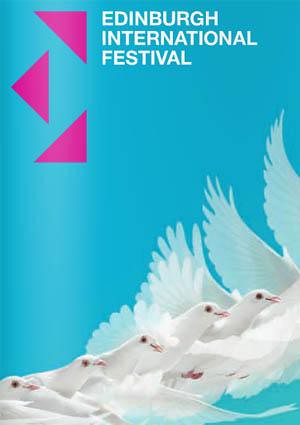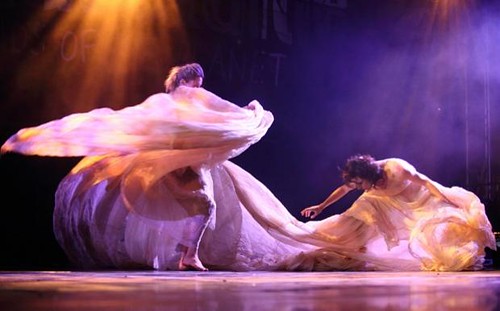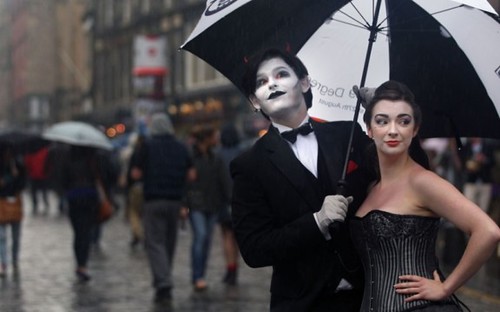Reflections on a Week at The EdinburghFestival
As New York glides into fall, the resonance of the Edinburgh Festival is still being felt. The prize-winning “smash hit” of the Fringe Festival, the South African “Mies Julie,” based on Strindberg’s “Miss Julie,” will open the season at St. Ann’s Warehouse in Brooklyn, November 8th, for a four week run. And, while the festival continues in Edinburgh, hosting International Storytelling,"exploring Grimm,” October 19 - 28th, the really big month is August.
This August, the final week was my last chance for a summer get away after being stuck in the city for two years.
I was lucky. Dear friends I’d missed for years had just moved back to Edinburgh and offered to put me up. When I arrived, I couldn’t believe my good fortune: their spacious top floor flat looked out on the truly magnificent Edinburgh Castle. The down side... I had to climb up 69 steps to get there.
August 2012: the jubilant London Olympics were ending, the Paralympics were getting underway and, in New York, the US Open was in high gear. In Edinburgh, I quickly learned, every August means the smallish population doubles, many locals leave town, renting their homes for huge sums and prices on everything go up. This glisteningly beautiful,formal, grey-stoned city brightens and colorful throngs of tourists mix with performers from all over the globe. The atmosphere crackles with energy and... dare I say it? Yes, it is truly festive.
This largest annual arts celebration in the world started in 1947 after the dark days of the war, as a way to inspire hope through cultural expression. For years, I’ve heard it referred to as “the festival,” but the first and most important thing to know is that it is not simply one cultural festival. It is many festivals – just put Edinburgh in front of the following and you’ll get the idea: Art Festival, Book Festival, Comedy Festival, Film festival, Jazz and Blues Festival, Fringe Festival, Television Festival, and then, there’s the Military Tattoo, a historical bagpipe extravaganza. It just keeps growing. To pull it all together, the overall umbrella organization of Festivals Edinburgh was created in 2007. But beneath this umbrella, all the festivals have different and separate organizers with separate administrations (Assembly Rooms, Pleasance Dome, The Gilded Balloon, Underbelly for the Fringe, for example, and Usher Hall, Queen’s Hall, Festival Theatre, Royal Highland Centre and Royal Lyceum for the International). There are hundreds of events taking place at the same time, in different disciplines, and in different locations. Without a plan, it can be daunting, confusing, even overwhelming. www.festivalsedinburgh.com is a good place to start for next year.
The upside is, even if you miss some events you want, there is so much going on, you’ll still have a great time. Art galleries and some events are free, and the buoyancy of the street performers alone — actors, clowns, musicians, stilt-walkers, puppeteers --- all promoting their shows daily on the Royal Mile --- is almost worth the trip.
Because I’d done due diligence, read reviews in advance and put my ear to the ground on arrival, I experienced some of the best the Festival had to offer. In the space of one week, I went to 11 events and soaked up the vibrant energy all around me.
I chose three festivals: the signature Edinburgh International Festival, the Fringe Festival and the International Book Festival. Here are some basics: The EIF – Edinburgh International Festival, is the original, invited festival at the core, with its ever expanding branches. It is elegant and dignified, yet unpretentious and venerated worldwide. While the EIF presents theatre and dance, its heart and soul has always been classical music. Major orchestral concerts, chamber recitals and half a dozen operas. Here, highly acclaimed world class artists perform each year. For this festival, it is wise to book tickets in advance.
The Fringe Festival on the other hand, is, by definition, anti-establishment, casual and controversial. The quality, while generally good, can vary. At that original 1947 festival, artists who weren't “invited” simply appeared, performed, and thus created “The Fringe.” Today, this experimental, no-holds barred and often political festival— theatre, comedy, cabaret and dance-- is, for many, synonymous with “the festival.” Throughout the month of August, there are literally several hundred Fringe events, from mid-morning into the wee hours, some free, sometimes in pubs. One official told me that if you went to all the events back to back it would take three years!
It was at the International that I saw two great, truly unique works of art, unlikely to be seen anywhere else: The Rape of Lucrece and Les Naufragés du Fol Espoir (Aurores). The first had only a single actor onstage: the great, young Irish actress Camille O'Sullivan, accompanied by pianist Feargal Murray. The Royal Shakespeare Company’s presentation of Shakespeare’s poem, “The Rape of Lucrece” was simply and movingly performed in song. This tale of rape and subsequent suicide in the ancient corridors of power, in Ms. O’ Sullivan’s velvet voice, haunts me still with the modern knowledge of how societies have often destroyed women over this subject.
The second had a cast of countless characters, the actors doubling in many parts: Les Naufragés du Fol Espoir (Aurores) or the Castaways of the Fol Espoir) (Sunrises), is a four hour epic created by the visionary French director, Ariane Mnouchkine’s Theéâtre du Soleil. Both works deserve the description “tour de force” and are examples of why devotees travel to Edinburgh.
Having missed Mnouchkine, now in her early 70s, at the Lincoln Center Festival in 2009, I was anxious to see this theatre legend’s work for the first time. The company, founded in the 60s, is a socialist collective, based in an old munitions factory just outside Paris. Each work is the result of months, often years of collaboration.
The audience get unwittingly involved en route to their seats, passing the actors, seen behind sheer-netted lace curtains, as they chat, apply make-up, slip into turn of the century costumes, read and relax. All clearly intentional preparation for the multi-layered artifice we’re about to experience.
Conceived by the company, the play, partially written by Hélène Cixous, is based on a posthumously published story by Jules Verne. The story, in 1914, tells of assassinations, archdukes, lovers, vicious bounty hunters, Indians and voyages to Patagonia. Like embedded Russian dolls, or a hall of mirrors, the play is a story within a story about making a silent film: a movie about a shipwreck and dashed visionary dreams. The primary stage is the rented attic of a favorite restaurant, the Fol du Espoir. English sub-titles are provided, as the story revolves around the left-wing filmmakers’ utopian ideals and the flaws of human nature (ego, lust, greed) that keep mankind from achieving them. Its brilliance was in achieving a full, deeply felt, portrait of humanity while we witness the openly artificial, melodramatic effects of silent film making. With each transparency, everything became more real. A panorama heightened by taking place on the eve of World War I.
At the Fringe Festival, I was treated to two plays performed by two exquisitely skilled actresses: Sandra Prinsloo in “The Sewing Machine” and Vicky Arcasis Casas in “Juana in a Million.” The organizer, Assembly Rooms, sponsored an invited South African season and imported the quietly touching "The Sewing Machine.” This is a story of an 82 year old Afrikaner woman, Magdaleen, now in a retirement home. Her best friend and confidante of 55 years, her sewing machine, has been by her side through adolescence, marriage, motherhood and South Africa's potent political changes over the years. Writer Rachel Greeff and director Hennie Van Gruenen did not shrink from the hard truths: Magdaleen, who had unthinkingly gone along with apartheid, is not always likeable. Movingly performed by the brilliant Sandra Prinsloo, the play reaches its apex with the memory of a family tragedy that transformed her. During this part, in the proverbial phrase, you could hear a pin drop. Allowed the privilege of seeing into this life, through the consummate skill of this great actress, the audience, too, was transformed. Finally, it was the power of universal truths of family, change, aging and loss that kept me and others in our seats, unable to move, for several minutes after the play ended.
Another Fringe “must see” was Pleasance Dome’s “Juana in a Million,” co-written by the Mexican actress Vicky Arcaico Casas and director Nir Paldi. Based on true stories, it is a tale of forced flight from a violent Mexican town, after witnessing a killing by a drug cartel. The actress, almost dancer-like, gives a powerful, physical performance, of a story partially rooted in her own experience. It tells of Juana, a young, naïve, undocumented Mexican immigrant, desperately seeking a new life in London. The detailed intricacies of that quest, the deceptions, abuse and exploitation, were beautifully paralleled with Mexico’s history at the hands of its invaders. After each searing performance, as the audience filed out, we were asked to donate to a London legal group in aid of the millions of Juanas. Wallets opened, coins jingled into the collection box and tears were wiped away. Including mine.
In seven days, I’d seen three EIF plays, four Fringe plays, gone to three book talks and an art exhibit/lecture. By now, both my energy and the festival were winding down.
It made me sad to see the white tents dismantled. Green, beautiful Charlotte Square had just hosted the Edinburgh International Book Festival in the 50th year of a powerful legacy: The World Writers’ Conference of 1962. And while the Book Festival started in 1983, it was that groundbreaking, notoriously contentious conference in the culturally fertile 60s that arguably parented the whole thing. The fiercely debated issues: censorship and the future of the novel.
In 2012, the atmosphere is, by comparison, sedate and genteel. After leaving a Fringe performance, I was lobbied by an enthusiastic performer, shoving a flyer into my hand, to attend his friend’s politically-oriented show that night. I told him I had a conflict, had to go to the Book Festival on the other side of town. “Why’d you want to go there,” he snorted in disbelief. “Good God ... it’s like being in bloody Hampstead! All those Ruperts and Cecils.” Yes, 2012. Sedate and genteel, but every now and then there’s a moment, sometimes an electric one.
Such a moment happened while I was there for Zadie Smith’s evening. It was the launch of the London native’s long-awaited fourth novel, “NW.” The event was sold out well in advance. Since “NW” was only released immediately after the book event, it couldn’t be discussed, but the devoted audience of Ruperts and Cecils hung on her every word. Smith is considered, by many, to be a wunderkind. Her first novel “White Teeth” debuted to thunderous acclaim, with comparisons to Dickens, when she was only 25. She is now 36 and a mother. With her previous 2005 novel, “On Beauty” also highly praised by the critics, she glided into the tent, her reputation secure, poised and self-assured, a tall slim figure wearing her signature turban. In the interview and the reading that followed, Ms. Smith did not disappoint. Though ”NW”, by now, widely reviewed, enthusiastically by some, less so by others, apparently did. But despite mixed reviews, no one could deny her brilliance. The novel centers on the section of London where Smith grew up, and examines the complicated lives of four people in their 30s who were born in the same housing estate or public housing.
She read a scene from “NW” about a playground incident that showed off her unerring ear for dialogue and satire. It pinpointed the crux of her many gifts: the layering of family and neighborhood characters, interacting in multi-cultural London’s complex landscape of race and class. There were, for me and others, a few surprises. She emphasized the contextual feeling of her book: her generation’s sense of ”genuine relativity,” of time speeding up as one grows older. This feeling is familiar to those of us who are older, but unusual for someone Smith’s age. Also, her talk of “self” and of her generation’s uncertainty of having a self. This was new and more personal. An existential reference I’d not heard before from this writer. That, coupled with her too sharp response to an innocent question about” voice,” provided fodder for the literati for weeks to come.
I was sitting next to the young black Canadian woman, a graduate student studying in Edinburgh, who asked Smith how she found her “voice” and the implied advice for herself and others in finding theirs. Ms. Smith’s dismissive response was adamant and felt like a rebuke, a slap on the wrist, or even a brush to the face. If I experienced embarrassment for my new best friend, others must have too. This, Smith said, was the sort of question her students often asked. Voice, she said firmly, is a "late capitalist construct.” A few moments later, both face and the day were saved, when Smith went on to say she wanted her novel “to demonstrate that people of color do not think of themselves as exotic or other to themselves. We think of ourselves as white people think of yourselves, as central to ourselves, and not some stylization, political points, added extras: none of those things.” The tension of the moment mercifully dissipated and the atmosphere was restored to its Hampstead gentility. My Canadian friend smiled, no doubt, relieved, as she nodded her head toward Smith, then me and said, “That’s what I was getting at. That’s what I wanted to know… what motivated her to write.” I, too, was relieved and pleased with this declaration, especially for my young Canadian friend. Perhaps, because we were the only discernible black people in the huge otherwise all white audience, I was, admittedly, still smarting from the reflected embarrassment of just a few seconds ago. It was, definitely, as they say,” a moment,” and Smith’s remarks about “voice” have spurred internet comments from others who were present.
Later, she shared an insight, central to her novel’s territory, dissecting the intricate and nuanced class system entrenched in London. “My feeling is that people in particular classes look on people in other classes with some kind of pity or sorrow, or with a feeling that life must, by necessity, be hard in this other class. My feeling is, having lived in different classes, that people want equality of opportunity…that’s the thing that makes me despair: the idea that people aren’t given equality of opportunity.” Smith divides her time between London and New York City, where she teaches creative writing at NYU.
Seven intense days. Exhilarating, but exhausting. Taxis were too expensive, buses too slow and in the peddie cabs, also no bargain, one risked life and limb every time your teenaged driver tested his brakes. Climbing those seven hills every day tested that old adage, "Whatever doesn’t kill you makes you stronger.” To say nothing of mounting the 69 steps, when I got home. It was like a week’s membership to a gym!
Finally, the sad truth is, you’d be lucky to see everything you want. I missed the sold out “must see” hit of the Fringe, “Mies Julie,” but happily, it’s scheduled for Brooklyn in November and London in March. Wherever you look, wherever you are “The Festival” still goes on.
In the last few years, the phrase “the take away” has come into the American lexicon. It refers to the kernel or core substance of useful, remembered information from an interview or a news story. It also implies something fast or quick. What, one wonders, is the term for that deeper than factual truth, an illumination experienced through a work of art, or from being in the presence of a great artist. Whatever it is – that now internalized memory of transformative art — I carry with me from that one week at the Edinburgh Festival.



